#morrosaurus
Text
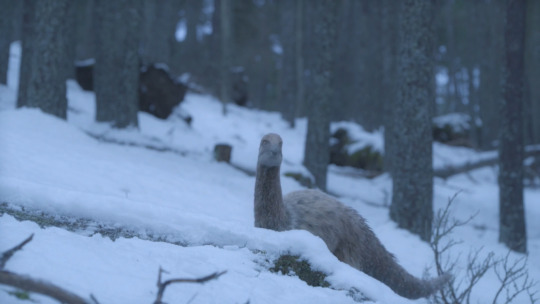
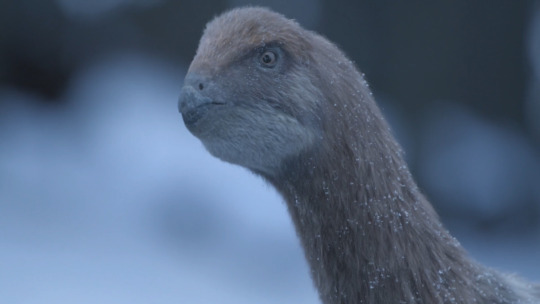

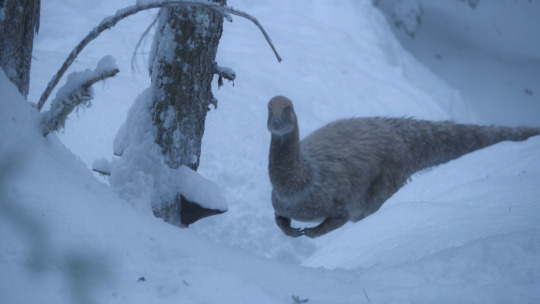
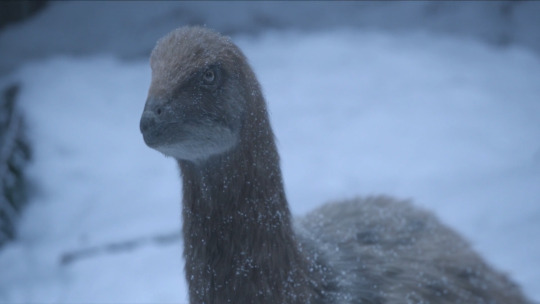
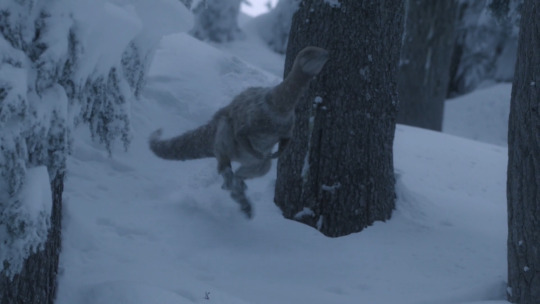

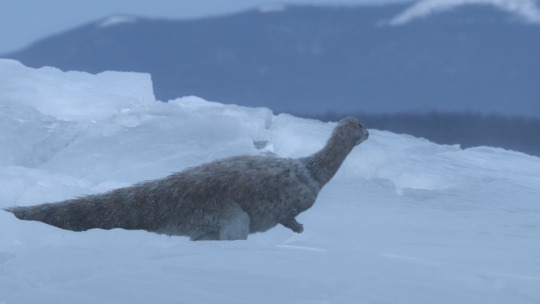
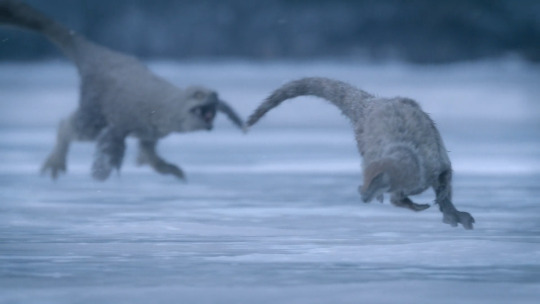
Life of our Prehistoric Planet: Morrosaurus antarcticus.
99 notes
·
View notes
Text
Been a while since I updated on the month drawing thing, so let me catch ye guys up!
Last few drawings of the past 2 months
- Hilda and an Ornitholestes watch some fireflies fly around
- Johanna hides from the spider-frog, but an Incisivosaurus may give her away
- Louise tries to take a picture of a Dilophosaurus, but she may be a bit too close
- Under the shade of a tree, Twig and a Tarchia wait for the sun to go down
- A Pachycephalosaurus earns a sweet meal at the cost of Louise getting stung by bees
- On a snorkeling trip, Johanna witnesses the arrival of new members of a Dolichorhynchops pod
- Hilda tries ice skating for the first time, her attempts being the entertainment center for a mother and baby Morrosaurus
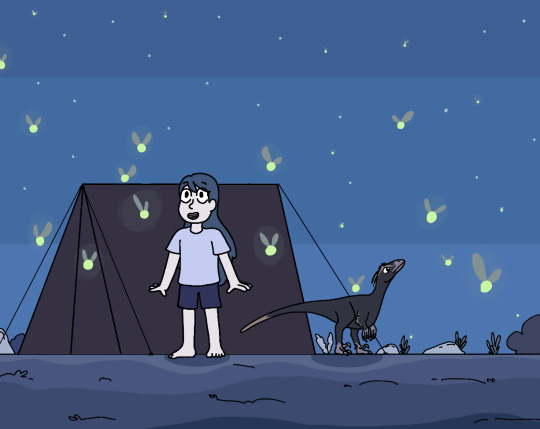


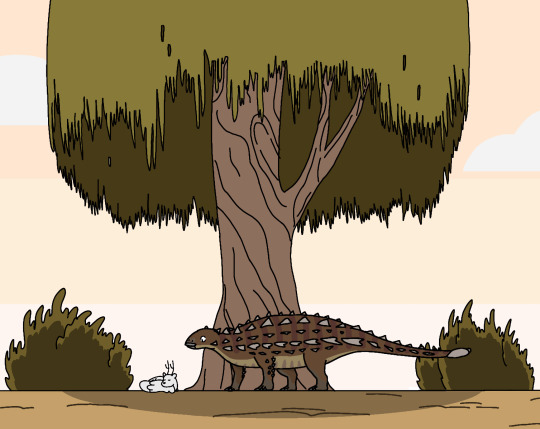
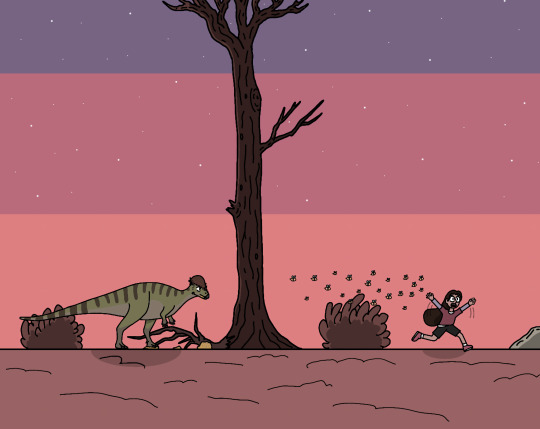
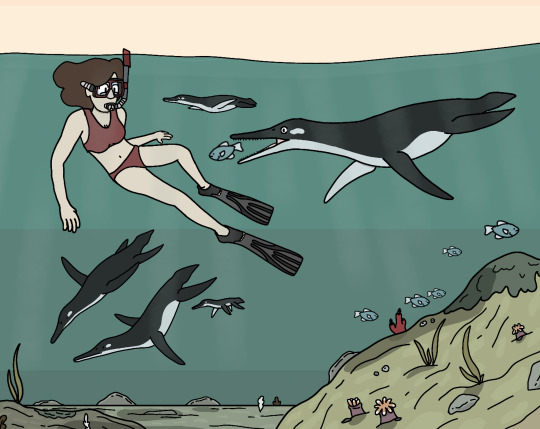

#drawing#dinosaur#marine reptile#hilda netflix#prehistoric planet season 2#hilda hilda#johanna hilda#louise hilda#twig the deerfox#ornitholestes#Incisivosaurus#Dilophosaurus#Tarchia#pachycephalosaurus#dolichorhynchops#Morrosaurus
10 notes
·
View notes
Text

Stargazing in the snow
#ultra ramblings#my artz#prehistoric planet#May-strichtian Madness 2#MaystrichtianMadness#morrosaurus
2 notes
·
View notes
Text

Morrosaurus
Morrosaurus — вимерлий рід травоїдних динозаврів з клади Elasmaria, що мешкав в кінці крейди в Антарктиді. Єдиним відомим видом є типовий вид — Morrosaurus antarcticus.
Повний текст на сайті "Вимерлий світ":
https://extinctworld.in.ua/morrosaurus/
#morrosaurus#antarctica#dinosaurs#herbivores#late cretaceous#cretaceous#apple#david attenborough#bbc#prehistoric planet#paleoart#hans zimmer#paleontology#prehistoric#animals#digital art#article#extinct#ua#fossils#палеонтологія#палеоарт#ukraine#ukrainian#palaeoblr#україна#мова#українцівтамблері#арт#динозавр
15 notes
·
View notes
Text
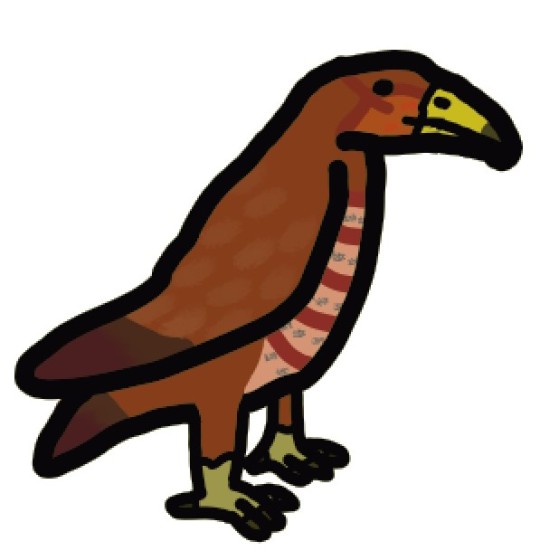

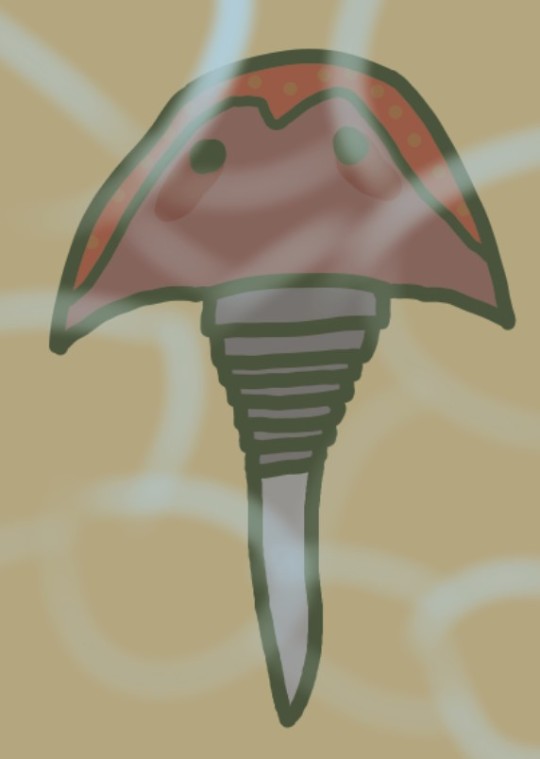
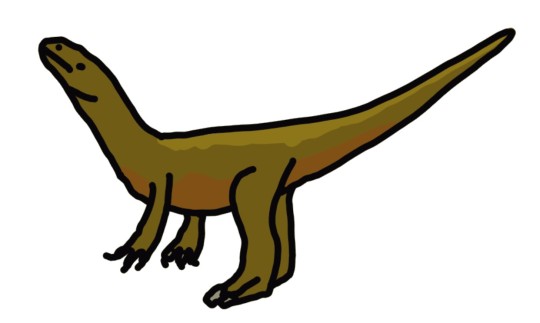
Flocking Together
Haast's Eagle/Morrosaurus
Houia/Saturnalia
6 notes
·
View notes
Text

Will it crack?
Morrosaurus, Cretaceous Antarctica
Patreon • Ko-fi • Facebook • Twitter • Prints & Merch
4K notes
·
View notes
Text
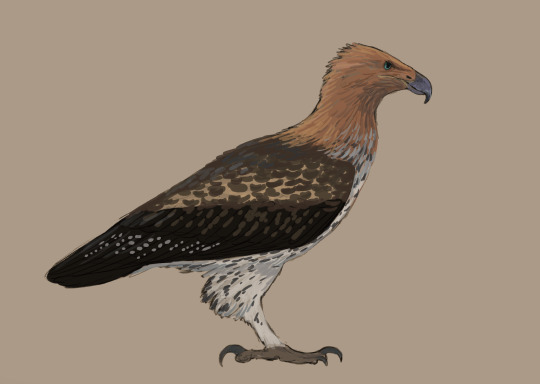

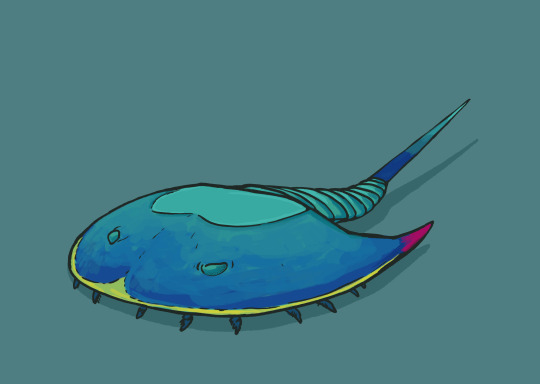
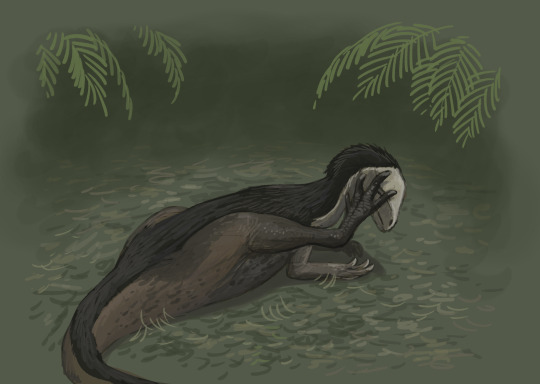
Results from the #paleostream!
Hieraaetus moorei, Morrosaurus, Houia yueya and Saturnalia.
335 notes
·
View notes
Text
Paleostream 11/17/2023



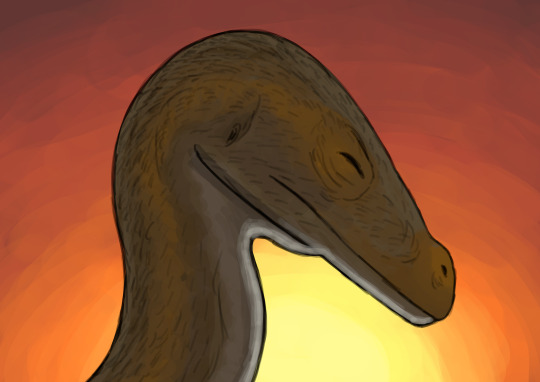
Some quick and fun and goofy sketches from today's flocking #paleostream featuring Haast’s eagle, Morrosaurus, Houia yueya, and Saturnalia. One of these is not like the others.
141 notes
·
View notes
Text

This is just so fucking cool man, there's not much more to say lol. I love when dinosaur documentaries do shit like this.

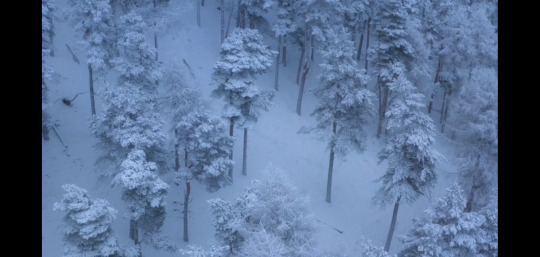
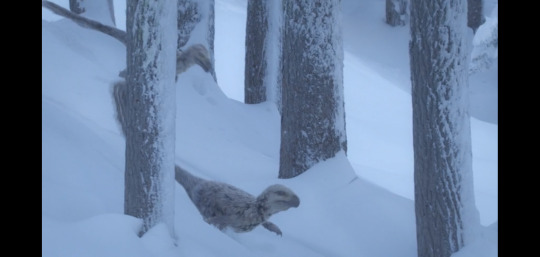

The Antarctica chase, a short but intense segment, the best part for me was the overhead shot of the Morrosaurus fleeing and than the pack of Imperobators flying out of the treeline after it. Gave a good sense of dread for the little guy.
38 notes
·
View notes
Text
Islands was a good start to Prehistoric Planet Season 2!
Kind of surprised we didn't start with Hatzegopteryx, kind of like a Season end to Season beginning transition. Zalmoxes was a nice way to start though. Wonder what that pterosaur was at the start? Also yeah, animals hop on rafts like that all the time. It's one way they can spread to new places.
Tethyshadros vs Hatzegopteryx was probably my favourite of the Europe segments, always nice to see the creepy giant giraffe storks in action. Should mention that Tethyshadros was found to be from earlier than the Maastrichtian stage so technically dated, but oh well. If this news somehow was able to drop earlier so it could inform the show, I could see this segment actually playing out pretty much the same. They already have Telmatosaurus models from last season, so yeah.
Was excited to see Simosuchus! Strange, unique crocodilian relative that is portrayed like it's a gopher. The injured Majungasaurus was a nice touch, trying to hunt smaller prey than often depicted doing.
Favourite segment was the Adalatheium one. Loved getting a Mesozoic mammal with the spotlight, also the babies seem to be live action rodents as the stand ins? Huh. Also nicely connected to the larger ecosystem. Like, we got the Majungasaurus, but also Masiakasaurus tried to hunt the cubs, only for itself to be hunted by a Madtsoia. Also seeing how Adalatherium be shown with familiar mammal traits but unique ones as well because it's Gondwanatherian and not close to any modern species.
Imperobator segment wasn't bad but still the weakest, just a theropod hunting ornithopod segment without much special. To be fair though, we don't know much about the species depicted (especially Imperobator, whose classification is just "Paravian"). Also, at least the Morrosaurus doesn't end up like small ornithopods in other documentaries and existed just to be theropod food, lol.
Hatzeg mating sequence had a lot spoiled and also I was at my limit with the internet but it was still cool to see the full thing! Nice continuity with the Tethyshadros being the prey the male shows, though I wish they explained how his crest and stuff got more colourful.
I think I can guess how it works, but still some clarification in the narration would've been nice. But yeah, was a cool final segment, even if I kind of wanted more based on the Season 1 episode structure. XP
Also can't help but wonder if Magyarosaurus or Paludititan were considered in any concept stages for the episode - I think to really show the strangeness of island dwarfism, seeing small Hateg sauropods would've sold that well.
9 notes
·
View notes
Text
Yeah yeah Imperobator blah blah blah theropods… HO YEAH MORROSAURUS
Finally an elasmarian on screen!! (I know Leaellynasaura might be one too but cmon give me this)…. So beautiful….
Also, both are new TV genera. Edit: Only Morrosaurus is new for TV
6 notes
·
View notes
Photo
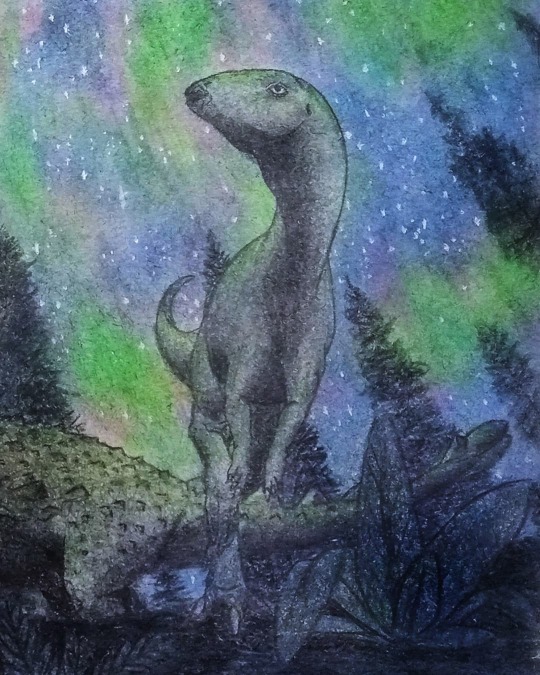
Hace 70 millones de años, debido al clima bastante más cálido que imperaba en la Tierra en aquel entonces, el paisaje antártico era bastante diferente del que podemos ver en la actualidad, y resultaba más parecido a lo que encontramos en latitudes patagónicas hoy en día. Amplios bosques de coníferas y plantas con flores dominaban el paisaje de la Antártida del Cretácico, y bajo las luces de la aurora austral un Morrosaurus antarcticus recorría lo que hoy es la Isla James Ross. Esta especie fue descrita por mi primo @sebarozadilla en el 2015, y pertenecía a ese grupo de dinosaurios "aburridos" del que les contaba ayer: los Ornitópodos. Particularmente, Morrosaurus (así como Anabisetia) integraba el clado conocido como Elasmaria, un grupo definido por Jorge @futalognko Calvo de pequeños dinosaurios herbívoros, parientes del famoso Iguanodon, adaptados a un estilo de vida bípedo corredor, y que poblaron lo que hoy es Sudamérica y la Antártida. ¡Saludos, y #SeanCreativos! 💭💡✏ 🇬🇧 70 million years ago, due to the much warmer climate that prevailed on Earth at that time, the Antarctic landscape was quite different from what we can see today, and it was more similar to what we find in Patagonian latitudes today. Vast coniferous forests and flowering plants dominated the landscspe of #Cretaceous #Antarctica, and under the lights of the southern #aurora a Morrosaurus antarcticus roamed what is now James Ross Island. This #dinosaur species was described by my cousin @sebarozadilla in 2015, and it belonged to that group of "boring" #dinosaurs I was telling you about yesterday: the #Ornithopods. In particular, Morrosaurus (as well as Anabisetia) was part of the clade known as Elasmaria, a group defined by Jorge @futalognko Calvo of small #herbivores, relatives of the famous #Iguanodon, adapted to a biped running lifestyle, and that populated what is now South America and Antarctica. Greetings, and #BeCreative! 💭💡✏ 🌐https://smart.bio/martintalone #illustration #drawing #artefcnym #paleontology #paleoart #prehistoric #fossil #fossilfriday #watercolours #colorpencils #night #sky #nightsky #northernlights #winter #winternights #jurassicpark #jurassicworld #ornithopod (en Martín Talone Art) https://www.instagram.com/p/CSm_mutHTkJ/?utm_medium=tumblr
#seancreativos#cretaceous#antarctica#aurora#dinosaur#dinosaurs#ornithopods#herbivores#iguanodon#becreative#illustration#drawing#artefcnym#paleontology#paleoart#prehistoric#fossil#fossilfriday#watercolours#colorpencils#night#sky#nightsky#northernlights#winter#winternights#jurassicpark#jurassicworld#ornithopod
33 notes
·
View notes
Text
Polarornis gregorii
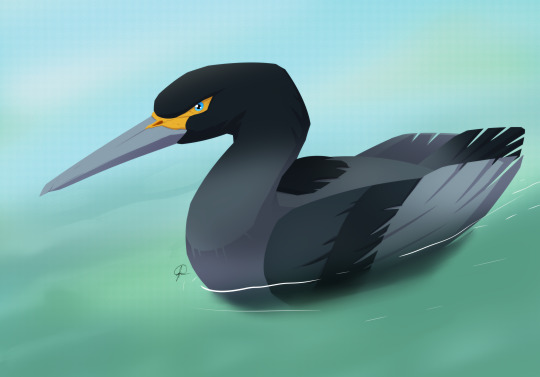
By José Carlos Cortés
Etymology: Polar Bird
First Described By: Chatterjee, 2002
Classification: Dinosauromorpha, Dinosauriformes, Dracohors, Dinosauria, Theropoda, Neotheropoda, Averostra, Tetanurae, Orionides, Avetheropoda, Coelurosauria, Tyrannoraptora, Maniraptoriformes, Maniraptora, Pennaraptora, Paraves, Eumaniraptora, Averaptora, Avialae, Euavialae, Avebrevicauda, Pygostylia, Ornithothoraces, Euornithes, Ornithuromorpha, Ornithurae, Neornithes, Neognathae, Galloanserae, Anseriformes, Vegaviidae
Status: Extinct
Time and Place: 66 million years ago, in the Maastrichtian age of the Late Cretaceous


Polarornis is known from the Lopez de Bertodano Formation of Seymour Island, Antarctica
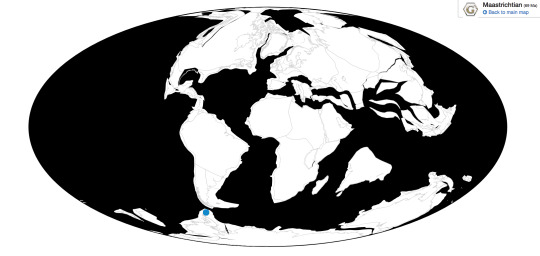
Physical Description: Polarornis was a fairly long duck-like dinosaur, around 80 centimeters in body length, though its wingspan and tail length are unknown. It would have had a fairly long looking body, with a long head and long neck (there’s a reason it was mistaken as a loon); the length of its legs is fairly unknown, but it had a short thigh and also had strong calf muscles. It had a long, narrow, toothless beak as well. Its wings aren’t well known, and it had very dense bones, so it may have had small wing. This makes it a fascinating case of a duck that evolved to look weirdly loon-like - convergent evolution is amazing!
Diet: Polarornis probably fed mainly on fish and aquatic invertebrates, especially given how many were there in its environment!
Behavior: Polarornis seems to have been flightless or nearly so, and probably spent most of its time in the water and as a diving dinosaur. This makes it a bird very similar to modern penguins and to contemporary hesperornithines! It would have probably used its legs extensively to kick and paddle through the water in search of food. As a diving bird in the far south, it also probably would have spent a lot of time preening, to keep its feathers waterproof and able to keep in warm air to protect it from the environment.
As an Anseriform, it is likely that Polarornis would take care of its young, and live in family groups; Polarornis young grew very quickly, especially for dinosaurs at the time, which would help it in the highly seasonal climates of Antarctica at the time. but beyond that it’s difficult to say what it would have acted like, beyond “duck-like”.
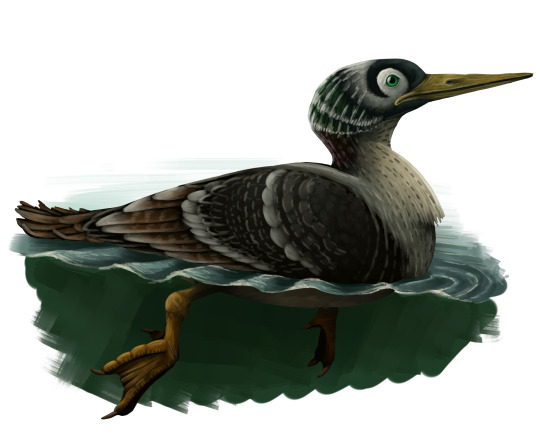
By Scott Reid
Ecosystem: Polarornis lived in the Lopez de Bertodano Formation, an antarctic shorline ecosystem from right before the end-Cretaceous extinction. Though Polarornis is known from the layer right before the extinction, nothing else is known from the same layer except some invertebrates such as bivalves, gastropods, and cephalopods. This was a mild arctic coastline ecosystem, with maritime climate and the higher temperature of the planet making it warmer than it would be today, but still very chilly for Mesozoic standards. Here there were many mosses, hornworts, liverworts, ferns, clubmosses, conifers, proteas, and beech trees. Other dinosaurs known from the layer just below Polarornis - and thus may have been around with Polarornis, we can’t entirely rule it out - includes the ornithopod Morrosaurus, the Anseriform Conflicto, and another Vegaviid Vegavis - in fact, I wouldn’t be surprised if Polarornis was the descendant of Vegaviis! There was also the Elasmosaurid Aristonectes and the Mosasaurid Kaikaifilu, which may have fed upon Polarornis. The Lopez de Bertodano Formation is thus a beautiful snapshot of the evolution of avian dinosaurs right up to the extinction of their nonavian relatives.
Other: Polarornis was originally thought to be a loon, and only recent studies have indicated that it belongs with animals like Vegavis and Australornis, in an early family of duck-forms from across the Cretaceous-Paleogene boundary. Polarornis, amongst others, were some of the handful of dinosaurs able to survive the asteroid impact, giving us all the birds we have today!
~ By Meig Dickson
Sources under the Cut
Agnolín, F. L., F. B. Egli, S. Chatterjee, J. A. Garcia Marsà, and F. E. Novas. 2017. Vegaviidae, a new clade of southern diving birds that survived the K/T boundary. The Science of Nature 104(87):1-9
Chatterjee, S. 2002. The morphology and systematics of Polarornis, a Cretaceous Loon (Aves: Gaviidae) from Antarctica. Proceedings of the 5th Symposium of the Society of Avian Paleontology and Evolution 125-155
Clarke, J. A., C. P. Tambussi, J. I. Noriega, G. M. Erickson, and R. A. Ketcham. 2005. Definitive fossil evidence for the extant avian radiation in the Cretaceous. Nature 433(20):305-308
Rozadilla, S., F. L. Agnolin, F. E. Novas, A. M. Aranciaga Rolando, M. J. Motta, J. M. Lirio, and M. P. Isasi. 2016. A new ornithopod (Dinosauria, Ornithischia) from the Upper Cretaceous of Antarctica and its palaeobiogeographical implications. Cretaceous Research 57:311-324
Tambussi, C. P., F. J. Degrange, R. S. Mendoza, E. Sferco, and S. Santillana. 2019. A stem anseriform from the early Palaeocene of Antarctica provides new key evidence in the early evolution of waterfowl. Zoological Journal of the Linnean Society
#Polarornis#Polarornis gregorii#Bird#Vegaviid#Dinosaur#Birblr#Palaeoblr#Factfile#Anseriform#Galloanseran#Dinosaurs#Birds#Antarctica#Cretaceous#Piscivore#Water Wednesday#paleontology#prehistory#prehistoric life#biology#a dinosaur a day#a-dinosaur-a-day#dinosaur of the day#dinosaur-of-the-day#science#nature
111 notes
·
View notes
Photo

Fly, a paired naayééʼ naal’eełí (Vegavis iaai) are flying over Antarctic elasmain Morrosaurus antarticus whiled it is looking at the above after heard a loud honk. As you can see, two fossilized member of Antarctic dinosaurs (especially include true bird) are from Lopez de Bertodano formation dating back in latest Cretaceous period. At first, the reason I make Vegavis fly because these are living descendants of the dinosaurs and the latter this one could be “Honk” as a true fossilized voice box has been discovered as suggested non-avian dinosaurs could used a better duck or goose-like sounds than mania used a lion-like roar. Another was Morrosaurus have a feather-like filaments after Kulindadromeus or technically Tianylong since this one lived in southern environment for cold winter months. Also since this is a basal Elasmaria, this is used to be Gondwanan iguanodontia, but later to place back to basal Ornithopod or actually Thescelosaurinae a subfamily.
#dinovember#drawdinovember#ornithopod#theropoda#bird#birds are dinosaurs#vegavis iaai#paleoart#Elasmaria#dinosaurs#ornithischia#ornithoscelida#my art
1 note
·
View note
Photo

Desde que leí por primera vez el significado de un nombre científico en un libro sobre dinosaurios (Stegosaurus= "lagarto con techo") he desarrollado cierta fascinación por la Etimología, que es la disciplina lingüística que estudia el significado, origen y evolución de las palabras. Desde que el naturalista sueco Carlos Linneo acuñó el sistema de nomenclatura binominal en el siglo XVIII, los nombres científicos de todos los seres vivos están compuestos por dos partes: un epíteto genérico y un epíteto específico, que denotan el género y la especie a la que pertenece un organismo (o el "nombre y apellido"). Así es como he ido aprendiendo, lenta y casi involuntariamente, a lo largo de los años, un poco de griego y de latín. Me encanta, cada vez que conozco un nombre nuevo, desglosarlo y tratar de discernir su significado. Pero hay veces que no es tan sencillo, ya que otros idiomas empiezan a ser incorporados al proceso. Talenkauen santacrucensis, por ejemplo, es un dinosaurio ornitópodo del Cretácico de Santa Cruz, Argentina, parecido a Anabisetia y Morrosaurus, pero con un cuello bastante más largo. Eso ha llevado a los paleontólogos a nombrarlo "cabeza pequeña". Pero en lugar de usar la terminología habitual y llamarlo "Microcephalus" o algo semejante, eligieron utilizar un vocablo en idioma Chon, la lengua hablada por los pueblos tehuelches y selk'nam de la Patagonia. Ejemplos como ese entre la fauna fósil argentina hay unos cuantos (en China también se está volviendo costumbre), y algunos de esos nombres me parecen simplemente magníficos. ¿Cuál es tu nombre científico favorito? ¡Saludos, y #SeanCreativos! 💭💡✏ 🌐https://smart.bio/martintalone #illustration #drawing #artefcnym #pencil #colorpencils #sketch #pencilsketch #pencildrawing #sketchbook #paleontology #paleoart #fossil #fossilfriday #dinosaur #dinosaurs #prehistoric #wildlife #jurassicpark #jurassicworld #ornitischia #ornitischian #ornithopod #herbivore #animal #animals #science #evolution #Argentina (en Martín Talone Art) https://www.instagram.com/p/CSsTfDJMkR3/?utm_medium=tumblr
#seancreativos#illustration#drawing#artefcnym#pencil#colorpencils#sketch#pencilsketch#pencildrawing#sketchbook#paleontology#paleoart#fossil#fossilfriday#dinosaur#dinosaurs#prehistoric#wildlife#jurassicpark#jurassicworld#ornitischia#ornitischian#ornithopod#herbivore#animal#animals#science#evolution#argentina
4 notes
·
View notes
Photo
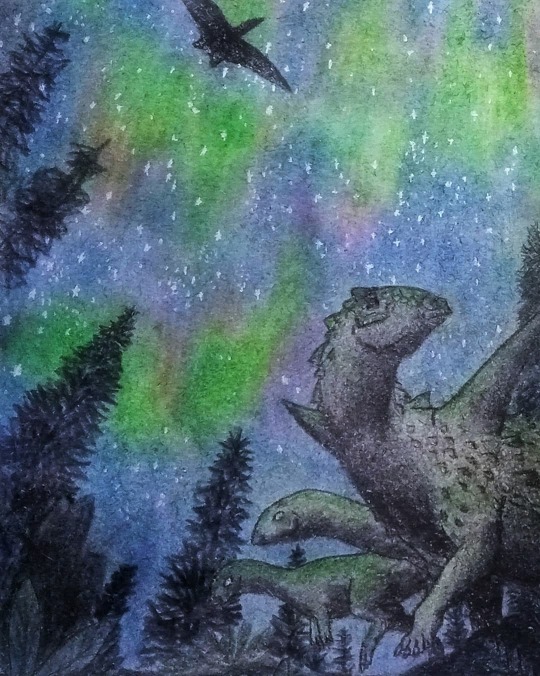
Morrosaurus tal vez haya coexistido brevemente con el Antarctopelta oliveroi, el primer dinosaurio descubierto en la Antártida. Antarctopelta era un anquilosaurio o dinosaurio acorazado, un pesado herbívoro con una armadura formada por placas y púas de hueso embebidas en la piel, que le habría servido como protección ante los ataques de depredadores; aunque el único carnívoro que se conoce de la Antártida con una antiguedad similar era Imperobator. Aún no sabemos si Antarctopelta presentaba o no un mazo en el extremo de su cola como otros dinosaurios acorazados, y esto se debe a que las condiciones climáticas antárticas hacen muy difícil el trabajo de extracción de los restos, y la exposición al congelamiento puede fácilmente destruir los fósiles. En particular el trabajo de extracción y preparación del único ejemplar conocido de este animal tardó 10 años en llevarse a cabo. ¿Quién sabe cuántas otras sorpresas prehistóricas estén esperándonos bajo el hielo del continente blanco? ¡Saludos, y #SeanCreativos!💭💡✏ 🇬🇧 Morrosaurus may have briefly coexisted with Antarctopelta oliveroi, the first #dinosaur ever discovered in #Antarctica. Antarctopelta was an #ankylosaur or #armored dinosaur, a heavy #herbivore with an armor made up of bone plates and spikes embedded in the skin, which would have served as protection against predatory attacks, although the only carnivore known from Antarctica with a similar age was Imperobator. We still do not know whether or not Antarctopelta had a mallet thagomizer at the end of its tail like other armored #dinosaurs, and this is because Antarctic weather conditions make the work of extracting the remains very difficult, and exposure to freezing can easily destroy the #fossils. In particular, the extraction and preparation work of the only known specimen of this #animal took 10 years to carry out. Who knows how many other #prehistoric surprises are waiting for us under the ice of the white continent? Greetings, and #BeCreative!💭💡✏ 🌐https://smart.bio/martintalone #illustration #drawing #artefcnym #paleontology #paleoart #fossilfriday #animals #northernlights #aurora #night #sky #nightsky #cretaceous #watercolor #colorpencils (en Martín Talone Art) https://www.instagram.com/p/CSpUg2rHLrn/?utm_medium=tumblr
#seancreativos#dinosaur#antarctica#ankylosaur#armored#herbivore#dinosaurs#fossils#animal#prehistoric#becreative#illustration#drawing#artefcnym#paleontology#paleoart#fossilfriday#animals#northernlights#aurora#night#sky#nightsky#cretaceous#watercolor#colorpencils
4 notes
·
View notes